近日,天津大学、物质绿色创造与制造海河实验室科研骨干杨全红 教授&翁哲 教授&韩大量 助理研究员 团队等人在Angew上发表重要文章,论文题为“A Self-Deoxidizing Electrolyte Additive Enables Highly Stable Aqueous Zinc Batteries”。在含水锌(Zn)电池中,锌负极遭受严重的腐蚀反应和随之而来的枝晶生长问题,导致性能快速衰减。在此,作者揭示了腐蚀机制,并证实除了质子之外,溶解氧(DO)是锌腐蚀和副产物沉淀的主要来源,特别是在电池初始休息期间。在突破常见的物理脱氧方法的基础上,作者提出了一种化学自脱氧策略来解决DO引起的危害。作为概念的证明,将蒽醌-2-磺酸钠(AQS)作为自脱氧添加剂引入水溶液中。结果表明,锌负极在0.5 mA cm-2下可长期循环2500小时,在5 mA cm-2下可长期循环1100小时,库仑效率高达99.6%。经过500次循环后,充满的电池也显示出92%的高容量保留率。这项研究结果为锌在水溶液中的腐蚀提供了新的认识,也为实现锌水溶液电池的工业化提供了实用的解决方案。

第一作者:Rui Sun
通讯作者:Daliang Han, Zhe Weng, Quan-Hong Yang
通讯单位:天津大学论文
DOI:10.1002/anie.202303557
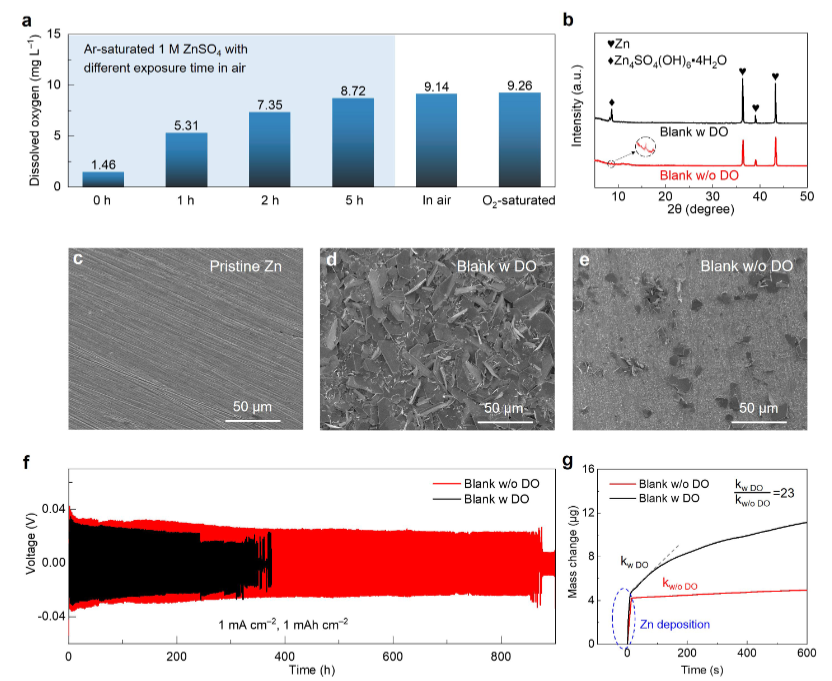
Figure 1. Hazards of DO on Zn anodes in 1 M ZnSO4 electrolytes. a) DO concentration in theelectrolytes (Ar-saturated one with gradually prolonged air exposure time, one prepared in air, and O2-saturated one) at room temperature. b) XRD patterns of the Zn anodes soaked in aqueous electrolyteswith and without DO. c‒e) SEM images of the c) pristine Zn foil and those soaked in electrolytes d) with and e) without DO. f) Galvanostatic cycling of Zn||Zn symmetric cells with different electrolytes. g) Mass change of Zn electrodes in electrolytes with and without DO.
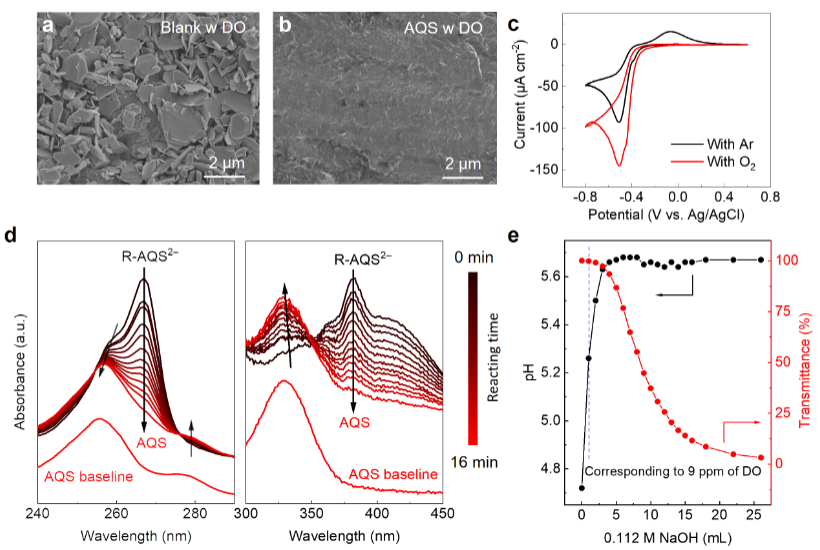
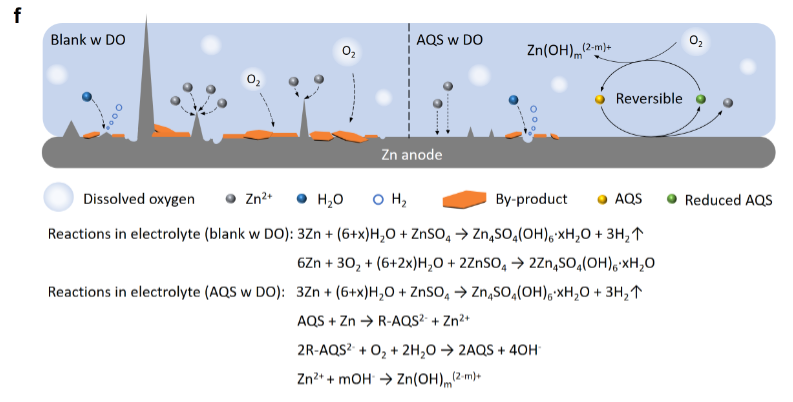
Figure 2. Self-deoxygenation evaluation of AQS in aqueous electrolytes. a‒b) SEM images of the Zn anodes disassembled from the coin cells using DO-contained electrolytes a) without and b) with AQS. c) CV curves of AQS in electrolytes saturated with O2 or Ar. d) UV-vis spectra of R-AQS2‒ holding in air at different reacting time. e) pH evolution of the aqueous ZnSO4 electrolyte with continuous addition of NaOH and its corresponding transmittance change. f) Schematic illustration for the reactions on the Zn anode and its surface evolution in DO-contained electrolytes with and without AQS.
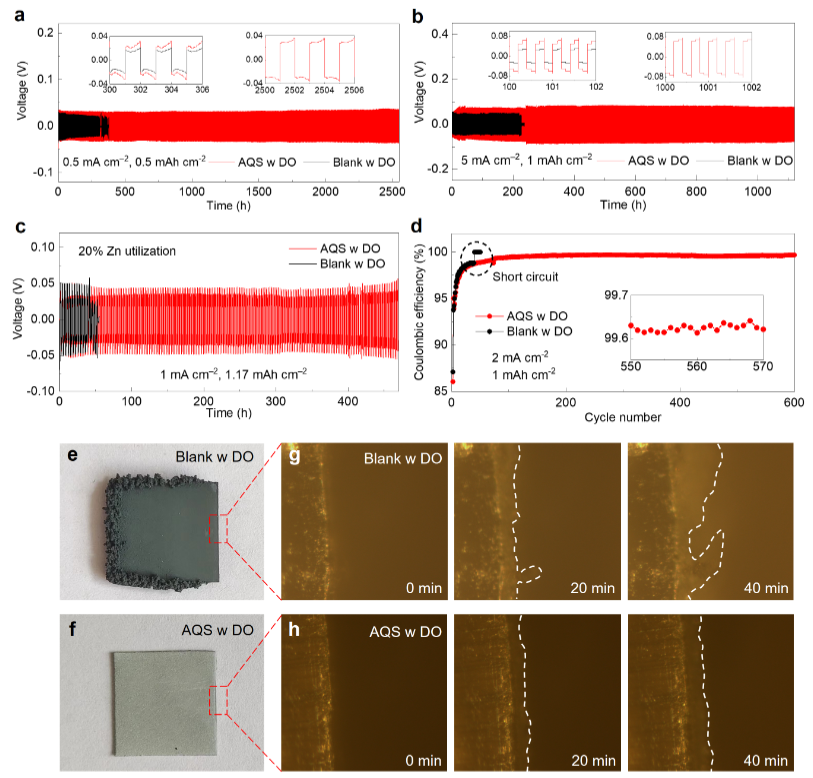
Figure 3. Electrochemical performance of Zn anodes after adding AQS. a‒b) Galvanostatic cycling of Zn||Zn symmetric cells in the electrolytes with and without AQS at a) 0.5 mA cm‒2 and 0.5 mAh cm‒2, and b) 5 mA cm‒2 and 1 mAh cm‒2. Insets show the detailed voltage profiles at specific cycles. c) Galvanostatic cycling of Zn||Zn symmetric cells under 20% depth of discharge at 1 mA cm‒2 and 1.17 mAh cm‒2. d) CE of Zn||Cu asymmetric cells with and without AQS. All cells were assembled in air without any deoxygenation treatment. e‒f) Optical photographs of the Zn foils deposited in the electrolytes e) without and f) with AQS. g‒h) Operando optical microscope images of Zn anodes during deposition at 10 mA cm−2 in the electrolytes g) without and h) with AQS.
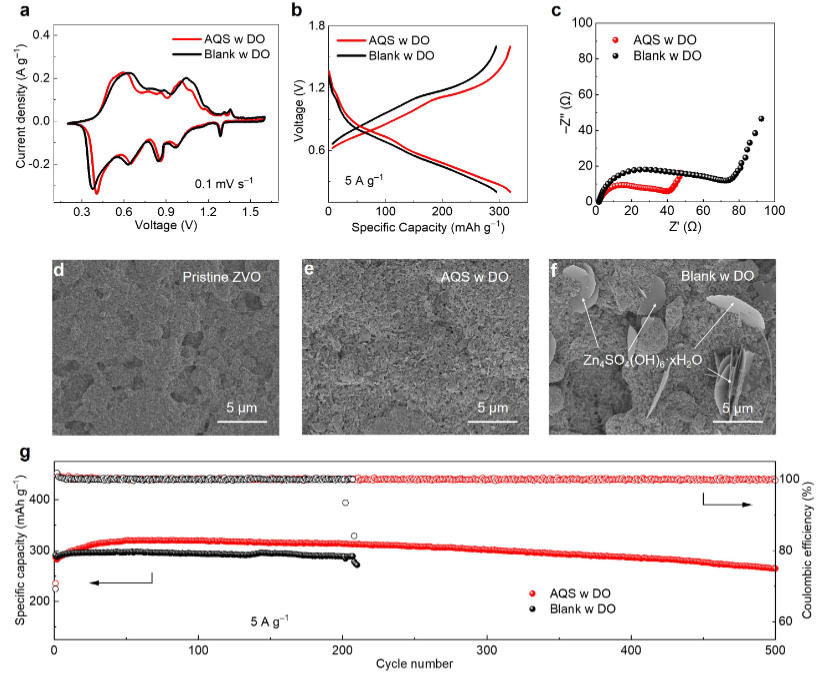
Figure 4. Electrochemical performance of Zn||ZVO full cells using the electrolytes with and without AQS. a) CV curves at a scan rate of 0.1 mV s‒1. b) Galvanostatic charge-discharge profiles at the 100th cycle. c) EIS plot after 100 cycles. d‒f) SEM images of the d) pristine ZVO and e, f) the cycledZVO after 50 cycles in the electrolytes e) with and f) without AQS. The cycled ZVO cathodes were at a fully charged state. g) Long-term cycling performance of Zn||ZVO full cells using the electrolytes with and without AQS at 5 A g‒1.
【总结】
作者确认氧气很容易溶解到水电解质中,并且很难用普通的物理方法去除。在初始静息阶段,DO是Zn腐蚀的主要原因,并伴随ZHS副产物在水溶液中析出,这将破坏随后的循环稳定性。AQS已被证明是一种有效的自脱氧添加剂,通过将DO还原反应的位置从Zn负极表面迁移到大部分电解质,可以解决DO引起的危害。这避免了OH-的局部富集,从而防止了不溶性副产物的沉淀。AQS的引入使锌负极的循环稳定性超过2500 h, CE高达99.6%。此外,AQS的自脱氧作用也有助于抑制质子插入/脱插入正极上ZHS的不可逆形成。结果表明,经过500次循环后,Zn||ZVO充满电池的容量保留率高达92%,大大优于无AQS的电池。这项工作不仅对锌在水溶液中的腐蚀有了新的认识,而且为水溶液电池的脱氧提供了一种全新的实用方法。自脱氧策略降低了普通物理方法的成本和复杂性,在所有水系电池的工业化中具有很大的前景。
来源:研图汇





